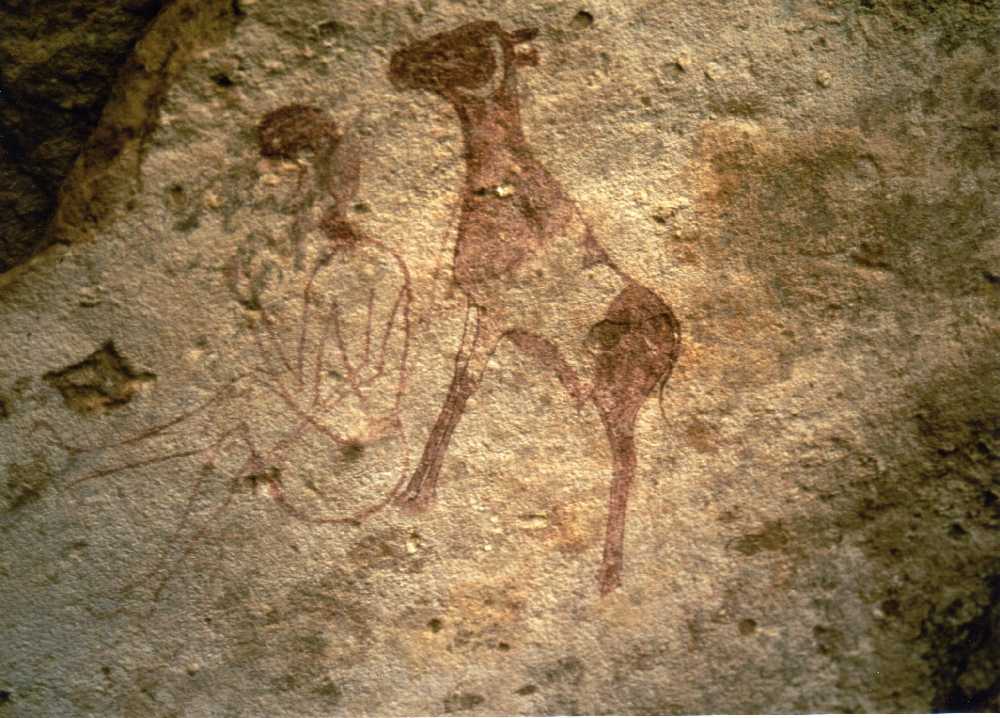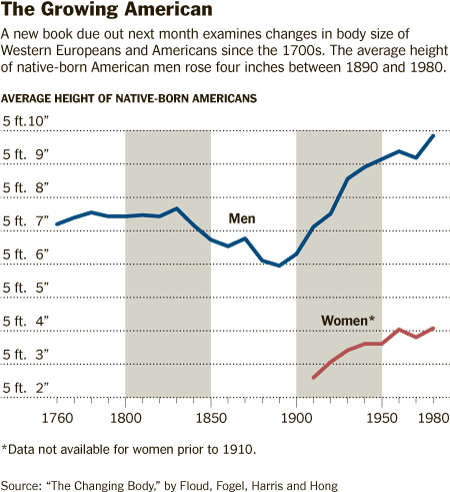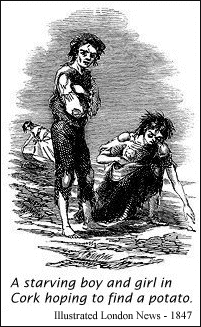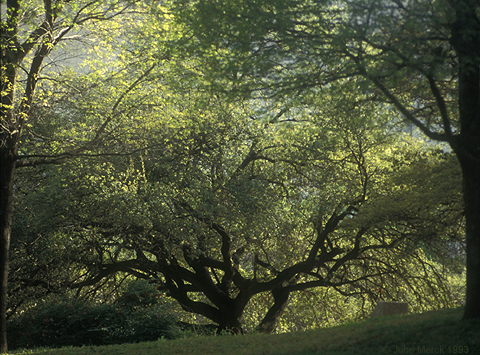The Crass Practicality: We EAT biodiversity
We have discussed the consequences of environmental richness or monotony for lemmings and proposed that it is analogous to the human need for diverse biological resources. Today we address the area in which the application of this principle has the biggest consequences: Agriculture.
The long view of monocultures:
Eleven thousand years ago, absolutely no one grew their own food. Instead they lived off of wild game, fish, and plants. Today only a tiny handful of people continue to live this way. Instead we live off of food that we cultivate deliberately or that someone else cultivates for us. Indeed, by the time everyone in this room is dead, there will probably be no primarily hunting and gathering cultures left. Their members will have dispersed and been assimilated by agricultural cultures.
Why did this change occur? After all, humans had done nicely as hunter/gatherers for many millenia. When you think about it in depth, this is really a restatement of Yali's question.
Traditionally, members of agricultural cultures would have answered that it was because of the inherent superiority of their life style, citing:
- The benefits of improved nutrition: Obviously members of today's agricultural societies have better nutrition than members of hunter/gatherer societies.
- Moral and cultural superiority of agriculturalists. Indeed, in the early history of our republic, the failure of Native Americans to do anything "productive" with their land (i.e. to farm it the way Europeans would) was a primary legal basis for not acknowledging their ownership of it. (Consider the Supreme Court's ruling on the issue of Native American title to the land they inhabit.
- "But the tribes of Indians inhabiting this country were fierce savages, whose occupation was war, and whose subsistence was drawn chiefly from the forest. To leave them in possession of their country, was to leave the country a wilderness..." (Chief Justice John Marshall, 1823)
A synthesis of current anthropological, archeological, and historical data that suggests something more complex happened.
Origins of Agriculture: Advantages of the hunter-gatherer life:
Summed up in one word: Health. Typically, ancient populations shifting from hunting-gathering to food production lost and average of six inches of stature and developed diet-related diseases including tooth decay. Not surprising considering that hunter-gatherers enjoyed a highly varied diet from diverse sources that was not overly dependent on complex carbohydrates. Why would anyone abandon this?
Advantages of food production:
- Manure for fertilizer
- Animal muscle strength for plowing.
- Chieftans and kings
- Priests
- Specialist craftsmen
- Scribes and Bureaucrats
- Soldiers
- Increased human fecundity: Hunter-gatherers must carry their children with them when shifting camp. Thus, a woman may have no more than one child too small to keep up on its own. Between lactational amenorrhea, the effects of a low-carbohydrate "wild" diet, and other measures, births to hunter-gatherers are typically spaced about four years apart. Farmers, in contrast, can support as many children as they can feed, and a high-carbohydrate diet facilitates frequent pregnancies.
Concentration of useful biomass: Most plants (99.9 %) are "weeds" - useless to humans. To have enough useful ones, hunter gatherers must control large areas with diverse species. Farmers can simply turn a small area over to a monoculture of the plants they need.
 Opportunity to domesticate livestock: Hunter-gatherers frequently move their camps. This eliminates the possibility of keeping large animals captive long enough to institute captive breeding. Farmers, in contrast, were responsible for major domestications of large herbivores. (Dogs, domesticated before the invention of agriculture, were a different story.)
Opportunity to domesticate livestock: Hunter-gatherers frequently move their camps. This eliminates the possibility of keeping large animals captive long enough to institute captive breeding. Farmers, in contrast, were responsible for major domestications of large herbivores. (Dogs, domesticated before the invention of agriculture, were a different story.)
 Use of livestock in agriculture:
Use of livestock in agriculture:
 Food storage: Hunter-gatherers have no effective means of long-term food storage. By favoring seed crops, farmers harvest the part of the plant that is capable of prolonged dormancy in the wild. Granaries give humans a buffer against unpredictable food shortages.
Food storage: Hunter-gatherers have no effective means of long-term food storage. By favoring seed crops, farmers harvest the part of the plant that is capable of prolonged dormancy in the wild. Granaries give humans a buffer against unpredictable food shortages.
 Division of labor: Once you have the ability to store food, it becomes possible to feed individuals who don't actual produce their own. Thus:
Division of labor: Once you have the ability to store food, it becomes possible to feed individuals who don't actual produce their own. Thus:
 But the big one:
But the big one:
- rising against their ruling class
- condemning much of their newly increased population to starvation.
When farmers and hunter-gatherers meet:
Such interactions aren't necessarily hostile. Indeed, cooperative arrangements based on division of labor can include:
- Cooperation between settled farmers and nomadic pastoralists. (E.G. traditional relationship of Hopis and Navajos.)
- Cooperation between settled farmers and forest specialists. (E.G. traditional relationship of Ituri Pygmies and their larger neighbors.)
So why do the non-agriculturalists always seem to disappear? When agriculturalists interact with their neighbors, they have certain advantages, regardless of their intentions:
- The ability to make more babies per unit of time.
- The ability to concentrate more people onto a given parcel of land.
- The inevitable tendency to transmit crowd diseases to their neighbors. NOTE: Typically an agricultural community will have some resistance to such diseases, either through childhood exposure or through evolved responses. Their hunter-gatherer neighbors will not. Thus:
Agriculturalists, who already had a population density advantage, will find themselves facing fewer and fewer hunter-gatherers because crowd diseases will kill more of them proportionally.
By this means a world of tall healthy hunter-gatherers was gradually replaced by one of little, sickly, but fecund agricultural monoculturists who did well in good times and whose societies collapsed in bad ones.
 Global economy and health:
Global economy and health:
All of this had changed by the dawn of the industrial age, when conditions combined to increase human health. (Stature, at right, is a good first-order proxy.)
- The development of a global economy and rapid transportation made it possible for agriculturalists to enjoy the kind of diet associated with hunting-gathering.
- The end of the little ice age increased growing seasons in industrial countries.
 However the incentives of industrial farming have brought the monoculture back in a new form.
However the incentives of industrial farming have brought the monoculture back in a new form.
Human agriculture and habitat diversity.
- Six varieties of corn -> 46 percent of the crop
- Nine varieties of wheat -> half of the wheat crop
- Two types of peas -> 96 percent of the pea crop.
- More than half the world's potato crop is made up of one variety of potato: the Russet Burbank favored by McDonalds.
- Economies of scale in actual farming
- Economies of scale in manufacture of a small number of types of generic farm machinery
- Maximizes yield allowing cheap food and surplus to export.
- Stimulates demand for products of allied industries
- Pesticides
- Fertilizers
- Machinery
- Antibiotics and other veterinary pharmaceuticals (keeping many animals at close quarters encourages spread of diseases.)
 But it has its down-side:
But it has its down-side:
- Concentration of uniform varieties of crops facilitates evolution of pests specifically adapted to them.
- Separation of farming of animals and plants means that waste that was once routinely recycled as fertilizer is now a large scale waste-disposal problem.
- Environmental risks of industrial farming: Pesticide pollution, eutrophication of waterways from fertilizer runoff.
But all of this is minor compared to the long term threat: The day may come when the pests evolve faster than our ability to cope with them. There have been foreshadowings:
- In 1970 the corn-leaf blight destroyed 60% of US corn production in a single summer.
- Human antibiotic use has facilitated the emergence of rather scary new pathogens, including, in recent years, a highly antibiotic-resistant tuberculosis in southern Africa. Of course, physicians have been training humans to take their full courses of antibiotics for a while. The widespread administration of antibiotics to farm animals (including as prophylaxis) amplifies the danger of the evolution of antibiotic-resistant pathogens that can then jump to humans. It's only a matter of time.
Thus, the human situation - dependance on an agricultural monoculture - mirrors that of the tundra lemmings - dependance on a natural monoculture, just on a longer time scale. Our monoculture is productive now, but the development of agricultural technologies must be in a constant race with:
- The evolution of pathogens
- The accumulation of environmental problems

- Prior to potato, roughly 1/3 of Ireland was too boggy or rocky to be arable by conventional means.
- Ireland's economy was dominated by absentee landlords who rented parcels to tenant farmers. Laws favoring landlords discouraged actual residents from making improvements to property.
- Changed with introduction of potato in 1590 - a low-maintainance crop that grew in otherwise waste regions. Indeed, the potato was more nutritious than alternative crops, and by 1800 Ireland was a potato monoculture for purely rational reasons.
- Between 1845 and 1851 the potato crop was largely destroyed by a fungal blight recently imported from the New World (Phytophthora infestans). During that interval Ireland's population dropped by roughly 20% (12% starved, 8% emmigrated) as food production failed and the economic system collapsed. (By British policy, food relief was to be funded by taxes on landlords who became bankrupt as they could no longer collect rent from starving tenants.)
- As bad as it was, the famine was mitigated by:
- Eventual aid from the British Crown.
- Proximity to places of refuge (England and North America)
- The fact that the blight was local.
Just a similar blight today effecting rice in mainland Asia.
 Is there a more fail-safe approach? In hindsight, the environmental mistakes we have reviewed are understandable:
Is there a more fail-safe approach? In hindsight, the environmental mistakes we have reviewed are understandable:
- People were doing what they were culturally accustomed to doing.
- But they did it in new geographic circumstances or with new materials
- And lacked institutions to coordinate responses to unusual threats
 The more we limit the diversity of the biological resources (crops) on which we depend, the more we set ourselves up for lemming-like boom and crash cycles. The alternative is deliberately to hedge our bets by cultivating a much wider range of crops than we think we need. In some ways, America is moving in this direction with:
The more we limit the diversity of the biological resources (crops) on which we depend, the more we set ourselves up for lemming-like boom and crash cycles. The alternative is deliberately to hedge our bets by cultivating a much wider range of crops than we think we need. In some ways, America is moving in this direction with:
- The current vogue for heirloom varities - a sort of cultivated plant antiquarianism - is keeping alive cultivars that might otherwise perish.
- The immigration of people from all over the world to North America creates a commercial demand for the food they ate back home. Thus items like manioc, jicama, tef, durian, and other crops unheard of in my youth are readily available at Giant or Safeway.
I began with the fates of lemmings in natural environments of variable diversity as a metaphor for the prospects of human society in unnatural agricultural environments, then gave anecdotes about human survivability. Can we put any of this on a more concrete footing?
Yes, we can.
Biological productivity as a function of diversity: In recent years, mathematical ecosystem models have become more sophisticated. Models of Loreau et. al. (2001) indicated that although stable environments at equilibrium may be most productive when dominated by a small number of species, the situation changed radically when environments were variable. In such cases, habitats with greater diversity were better able to cope with change without reducing productivity. This was true even though there was some element of chance regarding which species would ultimately become dominant. Thus, diversity is an asset to productivity in changing ecosystems.
 The coming food crisis: Currently there are roughly 7.1 billion humans. By 2050 there are expected to be nine billion, leading us to fear a future food crisis. Such fears are not new. In the 1970s (when Merck was you age) similar fears were being allayed by the green revolution in agricultural technologies whcih greatly increased productivity, especially in Asia. The differences between then and now:
The coming food crisis: Currently there are roughly 7.1 billion humans. By 2050 there are expected to be nine billion, leading us to fear a future food crisis. Such fears are not new. In the 1970s (when Merck was you age) similar fears were being allayed by the green revolution in agricultural technologies whcih greatly increased productivity, especially in Asia. The differences between then and now:
- There is almost no land suitable for agriculture that is not already under cultivation.
- Global fisheries are maxed out and, in some cases, on the point of collapse. (E.G. Atlantic bluefin tuna.)
- More large developing nations are demanding the resource share appropriate to affluent societies
- We also face the unpredictable effects of global climate change.
As a consequence, agricultural scientists are stepping up efforts to develop and deliver appropriate technologies such as:
- Fertilizers: Making them available and targeting them at the places where they are needed
- Water resources: Careful management of scarce water can make marginal lands productive
- Soils: Spreading known effective practices.
- Plant genetics: Developing crops that are both more productive and more tolerant of a range of environments.
- Infrastructure: Employing information technology to disseminate market, weather, and educational information to farmers everywhere.
 We may need to modify cultural approaches to food, including:
We may need to modify cultural approaches to food, including:
- Eating considerably less meat. Currently, a significant amount of grain goes to feed livestock, with the result that farm animals directly or indirectly use up to 80% of global agricultural land, but provide only 15% of calories. We can get more calories per acre globally by reducing meat consumption. (Coincidentally, we reduce risk of antibiotic resistant bugs.) Problematic in a world where newly affluent nations are increasing demand for meat.
- Expand our concept of "meat." A cow has to eat 8 grams of grain to gain one gram of weight. A grasshopper needs only two. Many societies, past and present, have eaten insects. Perhaps we should look to them as a protein resource. Such cultural adaptations are feasible. When Merck was young, the idea of an American eating squid or octopus was unthinkable.
Whatever the details, the general principles of our attitude toward biodiversity should be clear:
- Humans must maintain as broad a biological resource base as possible in order to assure a high future living standard.
- Natural biodiversity is the "mine" from which this resource base is derived. When we allow it to be destroyed, we destroy our own safety net.
- This conclusion is based entirely on pragmatic assessments of future needs, not on any sentimental attachment to biodiversity.